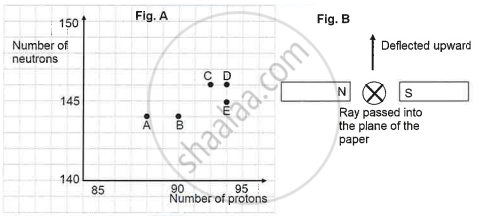Advertisements
Advertisements
प्रश्न
Observe the following figure:

If the current in the coil A is changed, will some current be induced in the coil B? Explain.
उत्तर
A current will be induced in Coil B. When there is a change in the current in Coil A, a magnetic field is associated with it. This induces a potential difference between the two coils which gives rise to a current in Coil B. This change can be noted by observing the deflection in the galvanometer.
APPEARS IN
संबंधित प्रश्न
The magnetic field inside a long straight solenoid-carrying current ______.
State Fleming’s left-hand rule.
Which of the following correctly describes the magnetic field near a long straight wire?
State whether the following statement is true or false
The field at the centre of a long circular coil carrying current will be parallel straight lines.
State the rule to determine the direction of a force experienced by a current-carrying straight conductor placed in a magnetic field which is perpendicular to it.
State Fleming's left hand rule.
Name the rule for finding the direction of magnetic field produced by a straight current-carrying conductor.
State the form of magnetic field lines around a straight current-carrying conductor.
What is the shape of a current-carrying conductor whose magnetic field pattern resembles that of a bar magnet?
Draw a sketch to show the magnetic lines of force due to a current-carrying straight conductor.
What are the various ways in which the strength of magnetic field produced by a current-carrying circular coil can be increased?
Name any two factors on which the strength of magnetic field produced by a current-carrying solenoid depends. How does it depend on these factors?
The magnetic field associated with a current-carrying straight conductor is in anticlockwise direction. If the conductor was held along the east-west direction, what will be the direction of current through it? Name and state the rule applied to determine the direction of current?
For Fleming's left-hand rule, write down the three things that are 90° to each other, and next to each one write down the finger or thumb that represents it.
State Fleming's left-hand rule. Explain it with the help of labelled diagrams.
The force exerted on a current-carrying wire placed in a magnetic field is zero when the angle between the wire and the direction of magnetic field is:
45°
60°
90°
180°
A horizontal wire carries a current as shown in Figure below between magnetic poles N and S:

Is the direction of the force on the wire due to the magnet:
(a) in the direction the current
(b) vertically downwards
(c) opposite to the current direction
(d) vertically upwards
If the current in a wire is flowing in the vertically downward direction and a magnetic field is applied from west to east, what is the direction of force in the wire?
State condition when magnitude of force on a current carrying conductor placed in a magnetic field is zero?
State the unit of magnetic field in terms of the force experienced by a current carrying conductor placed in a magnetic field
A coil ABCD mounted on an axle is placed between the poles N and S of a permanent magnet as shown in Figure.
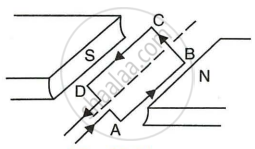
- In which direction will the coil begin to rotate when current is passed through the coil in direction ABCD by connecting a battery at the ends A and D of the coil?
- Why is a commutator necessary for continuous rotation of the coil?
- Complete the diagram with commutator, etc. for the flow of current in the coil?
i) Which principle is explained in this figure?
ii) Which rule is used to find out the direction of a force in this principle?
iii) In which machine this principle is used? Draw a diagram showing working of that machine
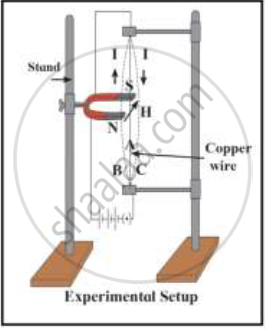
Name and state the rule of determine the direction of force experienced by a current carrying straight conductor placed in a uniform magnetic field which is perpendicular to it.
A flat coil ABCD is freely suspended between the pole pieces of a U-shaped permanent magnet with the plane of coil parallel to the magnetic field.
When will the couple acting on the coil be
- maximum
- minimum?
A flat coil ABCD is freely suspended between the pole of a U-shaped permanent magnet with the plane of coil parallel to the magnetic field.
Name an instrument which makes use of the principle stated above.
Differentiate between Conductors and insulators.
State whether a magnetic field is associated or not around a moving charge.
A current-carrying conductor is held in an exactly vertical direction. In order to produce a clockwise magnetic field around the conductor, the current should be passed in the conductor:
When current is parallel to a magnetic field, then force experience by the current-carrying conductor placed in a uniform magnetic field is ____________.
The diagram below shows a free conductor AB is kept in a magnetic field and is carrying current from A to B. (To avoid confusion complete path of the circuit is not shown) The direction of the force experienced by the conductor will be:
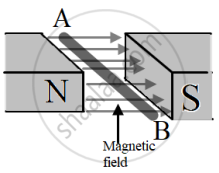
Describe the activity that shows that a current-carrying conductor experiences a force perpendicular to its length and the external magnetic field. How does Fleming’s left-hand rule help us to find the direction of the force acting on the current carrying conductor?
What do you know about Michael Faraday?
Observe the given figure of Fleming's Left Hand Rule and write the labels of 'A' and 'B':

An alpha particle enters a uniform magnetic field as shown. The direction of force experienced by the alpha particle is ______.
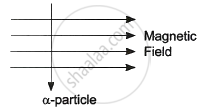
|
The graph (fig A) illustrates the correlation between the number of protons (x-axis) and the number of neutrons (y-axis) for elements A, B, C, D, and E in the periodic table. These elements are denoted by the letters rather than their conventional symbols. When the element C, depicted in the graph, undergoes radioactive decay, it releases radioactive rays. When these rays are directed into the plane of the paper in the presence of a magnetic field, as indicated in the fig B, they experience deflection, causing them to move upwards.
|
Name the law used to identify the radioactive radiation emitted by the element.
